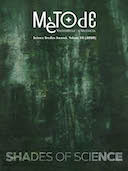Humans 2.0: Writing the future of human evolution
DOI:
https://doi.org/10.7203/metode.10.12554Keywords:
genome sequencing, genetic editing, human genetic modification, genetic determinism, bioethics Abstract
Abstract
Can humans control the future evolution of our species? Based on current knowledge in genetics, one can infer and extrapolate what may happen in the near future. After all, if we are to predict the future, we must first understand the foundations of our present. To answer the first question, I will briefly present what we know about our genome and whether we have enough data to infer who we are (known as the genotype–phenotype correlation), then I will present new technological advances and their potential impact on our evolution.
 Downloads
Downloads
 References
References
Apte, R. S. (2018). Gene therapy for retinal degeneration. Cell, 173(1), 5. doi: 10.1016/j.cell.2018.03.021
Beans, C. (2018). Science and culture: Wearable tech meets tattoo art in a bid to revolutionize both. Proceedings of the National Academy of Sciences of the USA, 115(14), 3504–3506. doi: 10.1073/pnas.1803214115
De Lecuona, I., Casado, M., Marfany, G., López-Baroni, M., & Escarrabill, M. (2017). Gene editing in humans: Towards a global and inclusive debate for responsible research.
Yale Journal of Biology and Medicine, 90(4), 673–681. PMID: 29259532
Gaskell, G., Bard, I., Allansdottir, A., Vieira da Cunha, R., Eduard, P., Hampel, J., ... Zwart, H. (2017). Public views on gene editing and its uses. Nature Biotechnology, 35, 1021–1023. doi: 10.1038/nbt.3958
Gerbault, P., Liebert, A., Itan, Y., Powell, P., Currat, M., Burger, J. ... Thomas, M. J. (2011). Evolution of lactase persistence: An example of human niche construction. Philosophical Transactions of the Royal Society of London B Biological Sciences, 366(1566), 863–877. doi: 10.1098/rstb.2010.0268
Hirsch, T., Rothoeft, T., Teig, N., Bauer, J. W., Pellegrini, G., De Rosa, L. ... De Luca, M. (2017). Regeneration of the entire human epidermis using transgenic stem cells. Nature, 551, 327–332. doi: 10.1038/nature24487
Kalia, S. S., Adelman, K., Bale, S. J., Chung, W. K., Eng, C., Evans, J. P. ... Miller, D. T. (2017). Recommendations for reporting of secondary findings in clinical exome and genome sequencing, 2016 update (ACMG SF v2.0): A policy statement of the American College of Medical Genetics and Genomics. Genetics in Medicine, 19(2), 249–255. doi: 10.1038/gim.2016.190
Ku, C. S., Polychronakos, C., Tan, E. K., Naidoo, N., Pawitan, Y., Roukos, D. H. ... Cooper D. N. (2013). A new paradigm emerges from the study of de novo mutations in the context of neurodevelopmental disease. Molecular Psychiatry, 18(2), 141–153. doi: 10.1038/mp.2012.58
Lim, E. T., Uddin, M., De Rubeis, S., Chan, Y., Kamumbu, A. S., Xhang, X., ... Walsh, C. A. (2017). Rates, distribution and implications of postzygotic mosaic mutations in autism spectrum disorder. Nature Neuroscience, 20, 1217–1224. doi: 10.1038/nn.4598
McCullough, J. M., Heath, K. M., & Smith, A. M. (2015). Hemochromatosis: Niche construction and the genetic domino effect in the European Neolithic. Human Biology, 87(1), 39–58. PMID: 26416321
Mojica, F. J. M., & Montoliu, L. (2016). On the origin of CRISPR-Cas technology: From prokaryotes to mammals. Trends in Microbiology, 24(10), 811–820. doi: 10.1016/j.tim.2016.06.005
Montoliu, L., Merchant, J., Hirsch, F., Abecassis, M., Jouannet, P., Baertschi, B., ... & Chneiweiss, H. (2018). ARRIGE arrives: Toward the responsible use of genome editing. The CRISPR Journal, 1(2), 128–129. doi: 10.1089/crispr.2018.29013.mil
Roukos, D. H. (2014). Innovation versus evidence: To trust direct-to-consumer personal genomic tests? Expert Review of Molecular Diagnostics, 11, 1–4. doi: 10.1586/erm.10.99
Santander, N. G., Contreras-Duarte, S., Awad, M. F., Lizama, C., Passalacqua, I., Rigotti, A., & Busso, D. (2013). Developmental abnormalities in mouse embryos lacking the HDL receptor SR-BI. Human Molecular Genetics, 22(6), 1086–1096. doi: 10.1093/hmg/dds510
The 1000 Genomes Project Consortium. (2015). A global reference for human genetic variation. Nature, 526, 68–74. doi: 10.1038/nature15393
Vernot, B., & Pääbo, S. (2018). The predecessors within... Cell, 173(1), 6–7. doi: 10.1016/j.cell.2018.03.023
Wang, H., La Russa, M., & Li, Q. S. (2016). CRISPR/Cas9 in genome editing and beyond. Annual Reviews in Biochemistry, 85, 227–264. doi: 10.1146/annurev-biochem-060815-014607
Downloads
Published
How to Cite
-
Abstract6812
-
PDF826
Issue
Section
License
![]()
All the documents in the OJS platform are open access and property of their respective authors.
Authors publishing in the journal agree to the following terms:
- Authors keep the rights and guarantee Metode Science Studies Journal the right to be the first publication of the document, licensed under a Creative Commons Attribution-NonCommercial-NoDerivatives 4.0 International License that allows others to share the work with an acknowledgement of authorship and publication in the journal.
- Authors are allowed and encouraged to spread their work through electronic means using personal or institutional websites (institutional open archives, personal websites or professional and academic networks profiles) once the text has been published.





